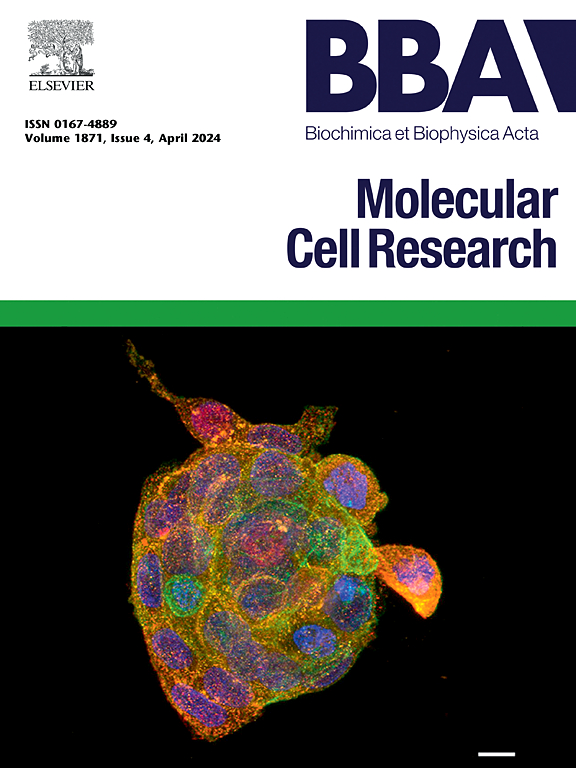常氧和缺氧条件下三维人肺上皮模型形态学和氧状态的表征
IF 3.7
2区 生物学
Q1 BIOCHEMISTRY & MOLECULAR BIOLOGY
Biochimica et biophysica acta. Molecular cell research
Pub Date : 2025-04-30
DOI:10.1016/j.bbamcr.2025.119980
引用次数: 0
摘要
感染在受影响组织中产生局部缺氧,诱导细胞生存反应并调节炎症过程。因此,在体外感染研究中考虑氧状态作为一个参数对于在3R背景下生成生理相关数据至关重要。在本研究中,我们对液-液界面(LLI)永久性支气管上皮细胞(Calu-3)、经典气-液界面(cALI) Calu-3和cALI人原代支气管上皮细胞(hBEC)模型在常压条件下的培养形态和氧合进行了表征。我们比较了这些模型的常氧状态和缺氧状态,以评估气道上皮环境在缺氧反应中的变化,以及在分子水平上观察到的选择性缺氧反应的程度。Calu-3 LLI和cALI模型与Calu-3常规单层(CM)和倒置气液界面(iALI)模型之间的并置,由于它们分别与基础和专业研究相关。观察到上皮复杂性在基于过滤器的模型中有所不同,并且发现所有模型在常氧条件下都表现出典型的细胞外氧消耗模式。重要的是,在常氧培养过程中,Calu-3 LLI、cALI和CM模型的细胞外氧含量显著降低。通过稳定HIF-1α、HIF-2α和/或HIF-3α以及改变ACE2蛋白水平而产生的特异性缺氧反应在不同的培养格式和细胞类型中有所不同。因此,虽然所有研究的模型都为体外探索提供了宝贵的机会,但在实验设计过程中,必须仔细考虑其形态、生理和分子特征的变化。本文章由计算机程序翻译,如有差异,请以英文原文为准。
Characterization of 3D human pulmonary epithelial model morphology and oxygen status under normoxia and hypoxia
Infection generates localized hypoxia in affected tissue, inducing cellular survival responses and modulating inflammatory processes. Consideration of oxygen status as a parameter in in vitro infection research is therefore vital to the generation of physiologically relevant data within the 3R context. In this study, we characterize the culture morphology and oxygenation of liquid-liquid interface (LLI) permanent bronchial epithelial (Calu-3), classical air-liquid interface (cALI) Calu-3, and cALI human primary bronchial epithelial cell (hBEC) models under the normoxic conditions within standard incubators, commonly employed in in vitro work. We compare the normoxic state of these models to their hypoxic state to assess changes in the airway epithelial environment in response to oxygen deprivation, and the extent to which select hypoxia responses can be observed at the molecular level. Additional juxtapositions are drawn between Calu-3 LLI and cALI models and Calu-3 conventional monolayer (CM) and inverted air-liquid interface (iALI) models, due to their relevance for basic and specialized research, respectively. Epithelial complexity was observed to vary amongst the filter-based models, and all models were found to exhibit characteristic extracellular oxygen depletion patterns under normoxia. Importantly, the extracellular oxygen contents of Calu-3 LLI, cALI, and CM models significantly decreased during normoxic incubation. Specific hypoxia responses through stabilization of HIF-1α, HIF-2α, and/or HIF-3α and alteration of ACE2 protein levels differed in response to both culture format and cell type. Therefore, while all models examined provide valuable opportunities for in vitro exploration, variation in their morphological, physiological, and molecular characteristics necessitates careful consideration during experimental design.
求助全文
通过发布文献求助,成功后即可免费获取论文全文。
去求助
来源期刊
CiteScore
10.00
自引率
2.00%
发文量
151
审稿时长
44 days
期刊介绍:
BBA Molecular Cell Research focuses on understanding the mechanisms of cellular processes at the molecular level. These include aspects of cellular signaling, signal transduction, cell cycle, apoptosis, intracellular trafficking, secretory and endocytic pathways, biogenesis of cell organelles, cytoskeletal structures, cellular interactions, cell/tissue differentiation and cellular enzymology. Also included are studies at the interface between Cell Biology and Biophysics which apply for example novel imaging methods for characterizing cellular processes.

 求助内容:
求助内容: 应助结果提醒方式:
应助结果提醒方式:


